(PDF) Human Factors in Systems Design
VerifiedAdded on 2021/06/17
|13
|3773
|71
AI Summary
Contribute Materials
Your contribution can guide someone’s learning journey. Share your
documents today.

HUMAN FACTORS IN SYSTEMS DESIGN
By
(Name)
(Course)
(Professor’s Name)
(Institution)
(State)
(Date)
By
(Name)
(Course)
(Professor’s Name)
(Institution)
(State)
(Date)
Secure Best Marks with AI Grader
Need help grading? Try our AI Grader for instant feedback on your assignments.

Interactive systems
Interactive systems are a collection of computer hardware and software entities that enable
human interaction through a user interface that enable input of instructions and output of
analysed or stored information.
MEDIGATE interactive system and its users.
As stated by Dix (2009), MEDIGATE interactive system is analysed and evaluated.
MEDIGATE is an interactive software able to run on Macintosh and Windows operating
system that allows input of data and visualize textual and graphic representation of the data.
The program utilizes the interface design of modern workstations to allow user interactivity
to input and visualize data. The interface includes input devices such as text fields, sizable
desktop windows, menus, icons and graphic designed objects that allow recording, analysis
and storage of medical data.
MEDIGATE interactive system is used by the medical professionals. The program acts as an
electronic recording tool that allows the replacement of the old and traditional manual file
records. The user population include medical employees in the different medical departments
responsible for the input and utilization of patient data such as the outpatient department, in-
patient department, laboratory and the pharmacy. The employees include clinical officers,
nurses, medical physicians, laboratory technicians, imaging consultants and pharmacists,
Reisner (2011).
It is reasonable to make the assumptions that the employees using the MEDIGATE software
program have the basic knowledge of computing. The knowledge include ability to work with
text input computer peripheral devices such as keyboards, ability to use computer mouse and
training on the basic computer packages such as Office, Excel and Spreadsheets.
The MEDIGATE use cases.
The MEDIGATE offers primarily a tool that is able to compliment if not replace the old and
traditional technique of records keeping.
According to Chin(2011), MEDIGATE is a wide tool used across the health care setting. Inn
this evaluation, focused is drawn to the usability of the program tool by the medical physician
in recording and computer assisted medical decisions through input of patient’s data through
Interactive systems are a collection of computer hardware and software entities that enable
human interaction through a user interface that enable input of instructions and output of
analysed or stored information.
MEDIGATE interactive system and its users.
As stated by Dix (2009), MEDIGATE interactive system is analysed and evaluated.
MEDIGATE is an interactive software able to run on Macintosh and Windows operating
system that allows input of data and visualize textual and graphic representation of the data.
The program utilizes the interface design of modern workstations to allow user interactivity
to input and visualize data. The interface includes input devices such as text fields, sizable
desktop windows, menus, icons and graphic designed objects that allow recording, analysis
and storage of medical data.
MEDIGATE interactive system is used by the medical professionals. The program acts as an
electronic recording tool that allows the replacement of the old and traditional manual file
records. The user population include medical employees in the different medical departments
responsible for the input and utilization of patient data such as the outpatient department, in-
patient department, laboratory and the pharmacy. The employees include clinical officers,
nurses, medical physicians, laboratory technicians, imaging consultants and pharmacists,
Reisner (2011).
It is reasonable to make the assumptions that the employees using the MEDIGATE software
program have the basic knowledge of computing. The knowledge include ability to work with
text input computer peripheral devices such as keyboards, ability to use computer mouse and
training on the basic computer packages such as Office, Excel and Spreadsheets.
The MEDIGATE use cases.
The MEDIGATE offers primarily a tool that is able to compliment if not replace the old and
traditional technique of records keeping.
According to Chin(2011), MEDIGATE is a wide tool used across the health care setting. Inn
this evaluation, focused is drawn to the usability of the program tool by the medical physician
in recording and computer assisted medical decisions through input of patient’s data through
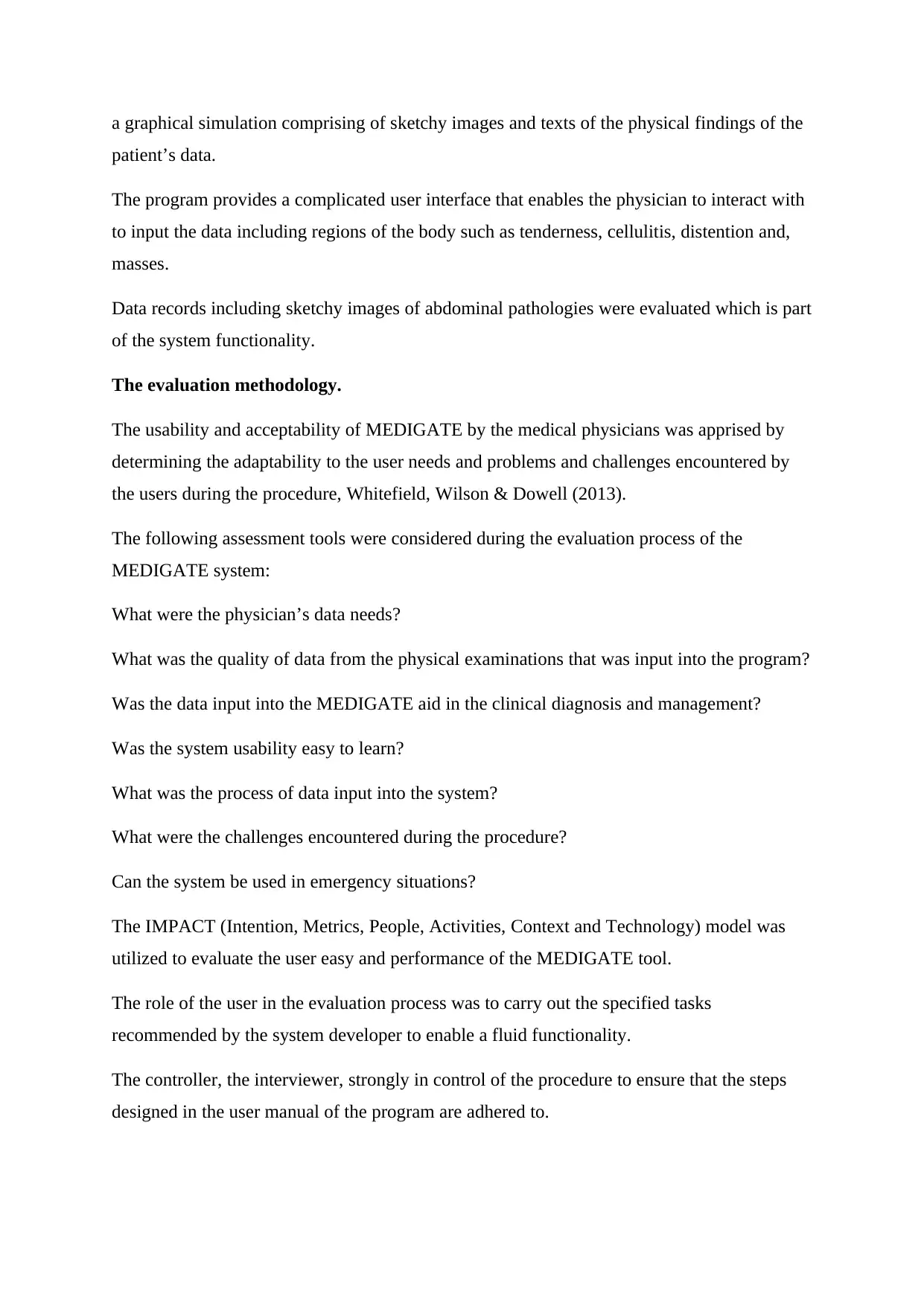
a graphical simulation comprising of sketchy images and texts of the physical findings of the
patient’s data.
The program provides a complicated user interface that enables the physician to interact with
to input the data including regions of the body such as tenderness, cellulitis, distention and,
masses.
Data records including sketchy images of abdominal pathologies were evaluated which is part
of the system functionality.
The evaluation methodology.
The usability and acceptability of MEDIGATE by the medical physicians was apprised by
determining the adaptability to the user needs and problems and challenges encountered by
the users during the procedure, Whitefield, Wilson & Dowell (2013).
The following assessment tools were considered during the evaluation process of the
MEDIGATE system:
What were the physician’s data needs?
What was the quality of data from the physical examinations that was input into the program?
Was the data input into the MEDIGATE aid in the clinical diagnosis and management?
Was the system usability easy to learn?
What was the process of data input into the system?
What were the challenges encountered during the procedure?
Can the system be used in emergency situations?
The IMPACT (Intention, Metrics, People, Activities, Context and Technology) model was
utilized to evaluate the user easy and performance of the MEDIGATE tool.
The role of the user in the evaluation process was to carry out the specified tasks
recommended by the system developer to enable a fluid functionality.
The controller, the interviewer, strongly in control of the procedure to ensure that the steps
designed in the user manual of the program are adhered to.
patient’s data.
The program provides a complicated user interface that enables the physician to interact with
to input the data including regions of the body such as tenderness, cellulitis, distention and,
masses.
Data records including sketchy images of abdominal pathologies were evaluated which is part
of the system functionality.
The evaluation methodology.
The usability and acceptability of MEDIGATE by the medical physicians was apprised by
determining the adaptability to the user needs and problems and challenges encountered by
the users during the procedure, Whitefield, Wilson & Dowell (2013).
The following assessment tools were considered during the evaluation process of the
MEDIGATE system:
What were the physician’s data needs?
What was the quality of data from the physical examinations that was input into the program?
Was the data input into the MEDIGATE aid in the clinical diagnosis and management?
Was the system usability easy to learn?
What was the process of data input into the system?
What were the challenges encountered during the procedure?
Can the system be used in emergency situations?
The IMPACT (Intention, Metrics, People, Activities, Context and Technology) model was
utilized to evaluate the user easy and performance of the MEDIGATE tool.
The role of the user in the evaluation process was to carry out the specified tasks
recommended by the system developer to enable a fluid functionality.
The controller, the interviewer, strongly in control of the procedure to ensure that the steps
designed in the user manual of the program are adhered to.
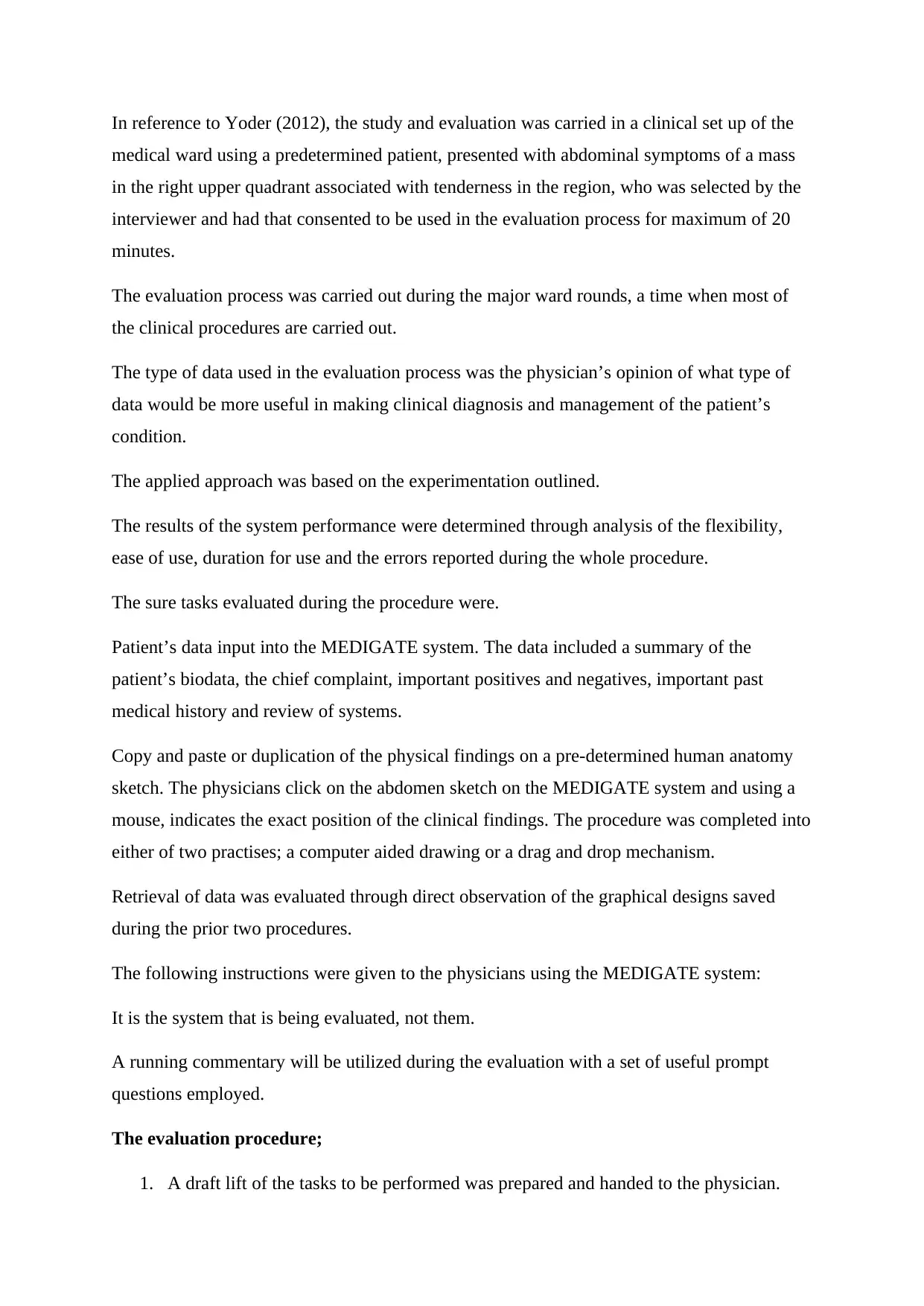
In reference to Yoder (2012), the study and evaluation was carried in a clinical set up of the
medical ward using a predetermined patient, presented with abdominal symptoms of a mass
in the right upper quadrant associated with tenderness in the region, who was selected by the
interviewer and had that consented to be used in the evaluation process for maximum of 20
minutes.
The evaluation process was carried out during the major ward rounds, a time when most of
the clinical procedures are carried out.
The type of data used in the evaluation process was the physician’s opinion of what type of
data would be more useful in making clinical diagnosis and management of the patient’s
condition.
The applied approach was based on the experimentation outlined.
The results of the system performance were determined through analysis of the flexibility,
ease of use, duration for use and the errors reported during the whole procedure.
The sure tasks evaluated during the procedure were.
Patient’s data input into the MEDIGATE system. The data included a summary of the
patient’s biodata, the chief complaint, important positives and negatives, important past
medical history and review of systems.
Copy and paste or duplication of the physical findings on a pre-determined human anatomy
sketch. The physicians click on the abdomen sketch on the MEDIGATE system and using a
mouse, indicates the exact position of the clinical findings. The procedure was completed into
either of two practises; a computer aided drawing or a drag and drop mechanism.
Retrieval of data was evaluated through direct observation of the graphical designs saved
during the prior two procedures.
The following instructions were given to the physicians using the MEDIGATE system:
It is the system that is being evaluated, not them.
A running commentary will be utilized during the evaluation with a set of useful prompt
questions employed.
The evaluation procedure;
1. A draft lift of the tasks to be performed was prepared and handed to the physician.
medical ward using a predetermined patient, presented with abdominal symptoms of a mass
in the right upper quadrant associated with tenderness in the region, who was selected by the
interviewer and had that consented to be used in the evaluation process for maximum of 20
minutes.
The evaluation process was carried out during the major ward rounds, a time when most of
the clinical procedures are carried out.
The type of data used in the evaluation process was the physician’s opinion of what type of
data would be more useful in making clinical diagnosis and management of the patient’s
condition.
The applied approach was based on the experimentation outlined.
The results of the system performance were determined through analysis of the flexibility,
ease of use, duration for use and the errors reported during the whole procedure.
The sure tasks evaluated during the procedure were.
Patient’s data input into the MEDIGATE system. The data included a summary of the
patient’s biodata, the chief complaint, important positives and negatives, important past
medical history and review of systems.
Copy and paste or duplication of the physical findings on a pre-determined human anatomy
sketch. The physicians click on the abdomen sketch on the MEDIGATE system and using a
mouse, indicates the exact position of the clinical findings. The procedure was completed into
either of two practises; a computer aided drawing or a drag and drop mechanism.
Retrieval of data was evaluated through direct observation of the graphical designs saved
during the prior two procedures.
The following instructions were given to the physicians using the MEDIGATE system:
It is the system that is being evaluated, not them.
A running commentary will be utilized during the evaluation with a set of useful prompt
questions employed.
The evaluation procedure;
1. A draft lift of the tasks to be performed was prepared and handed to the physician.
Secure Best Marks with AI Grader
Need help grading? Try our AI Grader for instant feedback on your assignments.
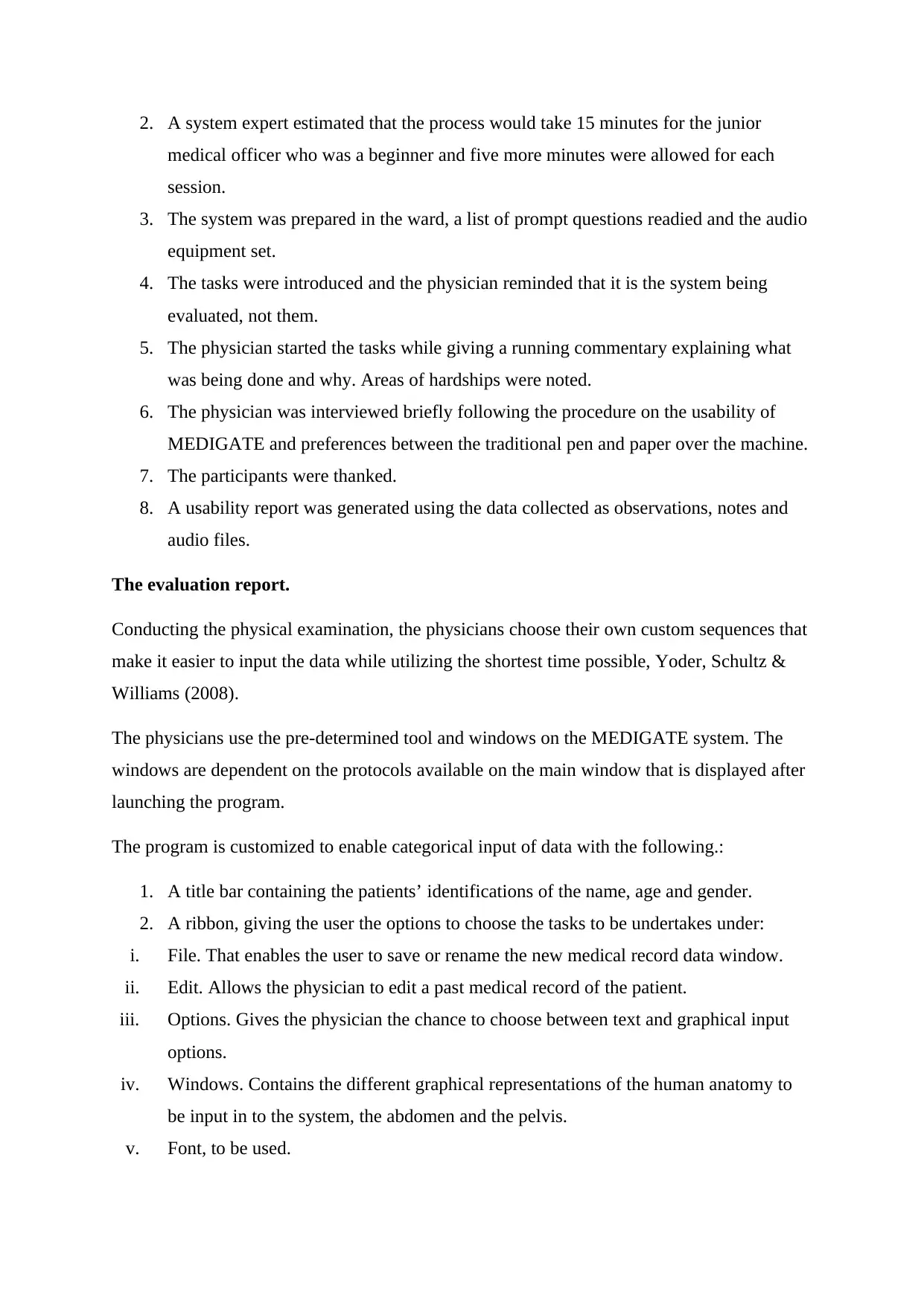
2. A system expert estimated that the process would take 15 minutes for the junior
medical officer who was a beginner and five more minutes were allowed for each
session.
3. The system was prepared in the ward, a list of prompt questions readied and the audio
equipment set.
4. The tasks were introduced and the physician reminded that it is the system being
evaluated, not them.
5. The physician started the tasks while giving a running commentary explaining what
was being done and why. Areas of hardships were noted.
6. The physician was interviewed briefly following the procedure on the usability of
MEDIGATE and preferences between the traditional pen and paper over the machine.
7. The participants were thanked.
8. A usability report was generated using the data collected as observations, notes and
audio files.
The evaluation report.
Conducting the physical examination, the physicians choose their own custom sequences that
make it easier to input the data while utilizing the shortest time possible, Yoder, Schultz &
Williams (2008).
The physicians use the pre-determined tool and windows on the MEDIGATE system. The
windows are dependent on the protocols available on the main window that is displayed after
launching the program.
The program is customized to enable categorical input of data with the following.:
1. A title bar containing the patients’ identifications of the name, age and gender.
2. A ribbon, giving the user the options to choose the tasks to be undertakes under:
i. File. That enables the user to save or rename the new medical record data window.
ii. Edit. Allows the physician to edit a past medical record of the patient.
iii. Options. Gives the physician the chance to choose between text and graphical input
options.
iv. Windows. Contains the different graphical representations of the human anatomy to
be input in to the system, the abdomen and the pelvis.
v. Font, to be used.
medical officer who was a beginner and five more minutes were allowed for each
session.
3. The system was prepared in the ward, a list of prompt questions readied and the audio
equipment set.
4. The tasks were introduced and the physician reminded that it is the system being
evaluated, not them.
5. The physician started the tasks while giving a running commentary explaining what
was being done and why. Areas of hardships were noted.
6. The physician was interviewed briefly following the procedure on the usability of
MEDIGATE and preferences between the traditional pen and paper over the machine.
7. The participants were thanked.
8. A usability report was generated using the data collected as observations, notes and
audio files.
The evaluation report.
Conducting the physical examination, the physicians choose their own custom sequences that
make it easier to input the data while utilizing the shortest time possible, Yoder, Schultz &
Williams (2008).
The physicians use the pre-determined tool and windows on the MEDIGATE system. The
windows are dependent on the protocols available on the main window that is displayed after
launching the program.
The program is customized to enable categorical input of data with the following.:
1. A title bar containing the patients’ identifications of the name, age and gender.
2. A ribbon, giving the user the options to choose the tasks to be undertakes under:
i. File. That enables the user to save or rename the new medical record data window.
ii. Edit. Allows the physician to edit a past medical record of the patient.
iii. Options. Gives the physician the chance to choose between text and graphical input
options.
iv. Windows. Contains the different graphical representations of the human anatomy to
be input in to the system, the abdomen and the pelvis.
v. Font, to be used.
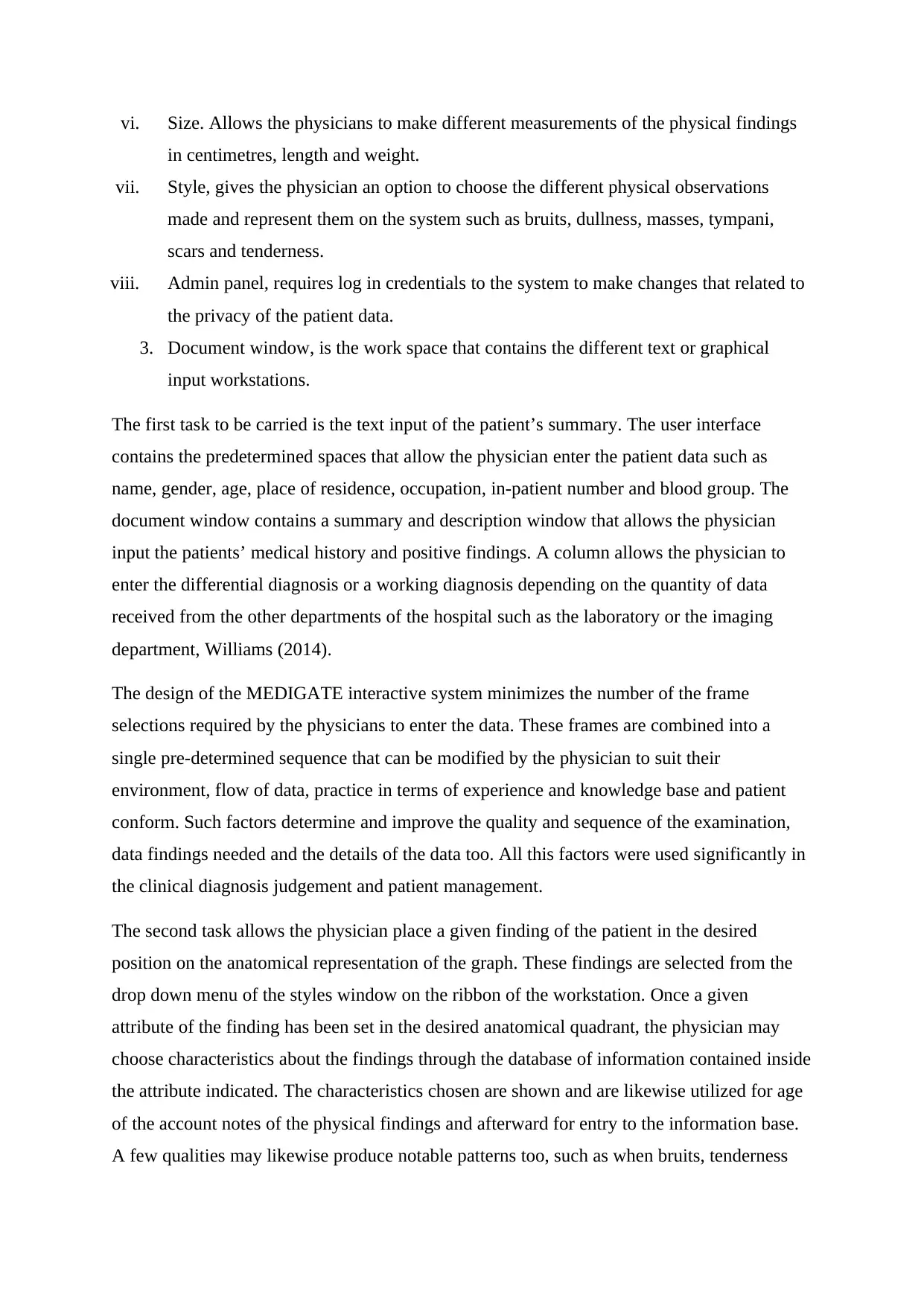
vi. Size. Allows the physicians to make different measurements of the physical findings
in centimetres, length and weight.
vii. Style, gives the physician an option to choose the different physical observations
made and represent them on the system such as bruits, dullness, masses, tympani,
scars and tenderness.
viii. Admin panel, requires log in credentials to the system to make changes that related to
the privacy of the patient data.
3. Document window, is the work space that contains the different text or graphical
input workstations.
The first task to be carried is the text input of the patient’s summary. The user interface
contains the predetermined spaces that allow the physician enter the patient data such as
name, gender, age, place of residence, occupation, in-patient number and blood group. The
document window contains a summary and description window that allows the physician
input the patients’ medical history and positive findings. A column allows the physician to
enter the differential diagnosis or a working diagnosis depending on the quantity of data
received from the other departments of the hospital such as the laboratory or the imaging
department, Williams (2014).
The design of the MEDIGATE interactive system minimizes the number of the frame
selections required by the physicians to enter the data. These frames are combined into a
single pre-determined sequence that can be modified by the physician to suit their
environment, flow of data, practice in terms of experience and knowledge base and patient
conform. Such factors determine and improve the quality and sequence of the examination,
data findings needed and the details of the data too. All this factors were used significantly in
the clinical diagnosis judgement and patient management.
The second task allows the physician place a given finding of the patient in the desired
position on the anatomical representation of the graph. These findings are selected from the
drop down menu of the styles window on the ribbon of the workstation. Once a given
attribute of the finding has been set in the desired anatomical quadrant, the physician may
choose characteristics about the findings through the database of information contained inside
the attribute indicated. The characteristics chosen are shown and are likewise utilized for age
of the account notes of the physical findings and afterward for entry to the information base.
A few qualities may likewise produce notable patterns too, such as when bruits, tenderness
in centimetres, length and weight.
vii. Style, gives the physician an option to choose the different physical observations
made and represent them on the system such as bruits, dullness, masses, tympani,
scars and tenderness.
viii. Admin panel, requires log in credentials to the system to make changes that related to
the privacy of the patient data.
3. Document window, is the work space that contains the different text or graphical
input workstations.
The first task to be carried is the text input of the patient’s summary. The user interface
contains the predetermined spaces that allow the physician enter the patient data such as
name, gender, age, place of residence, occupation, in-patient number and blood group. The
document window contains a summary and description window that allows the physician
input the patients’ medical history and positive findings. A column allows the physician to
enter the differential diagnosis or a working diagnosis depending on the quantity of data
received from the other departments of the hospital such as the laboratory or the imaging
department, Williams (2014).
The design of the MEDIGATE interactive system minimizes the number of the frame
selections required by the physicians to enter the data. These frames are combined into a
single pre-determined sequence that can be modified by the physician to suit their
environment, flow of data, practice in terms of experience and knowledge base and patient
conform. Such factors determine and improve the quality and sequence of the examination,
data findings needed and the details of the data too. All this factors were used significantly in
the clinical diagnosis judgement and patient management.
The second task allows the physician place a given finding of the patient in the desired
position on the anatomical representation of the graph. These findings are selected from the
drop down menu of the styles window on the ribbon of the workstation. Once a given
attribute of the finding has been set in the desired anatomical quadrant, the physician may
choose characteristics about the findings through the database of information contained inside
the attribute indicated. The characteristics chosen are shown and are likewise utilized for age
of the account notes of the physical findings and afterward for entry to the information base.
A few qualities may likewise produce notable patterns too, such as when bruits, tenderness
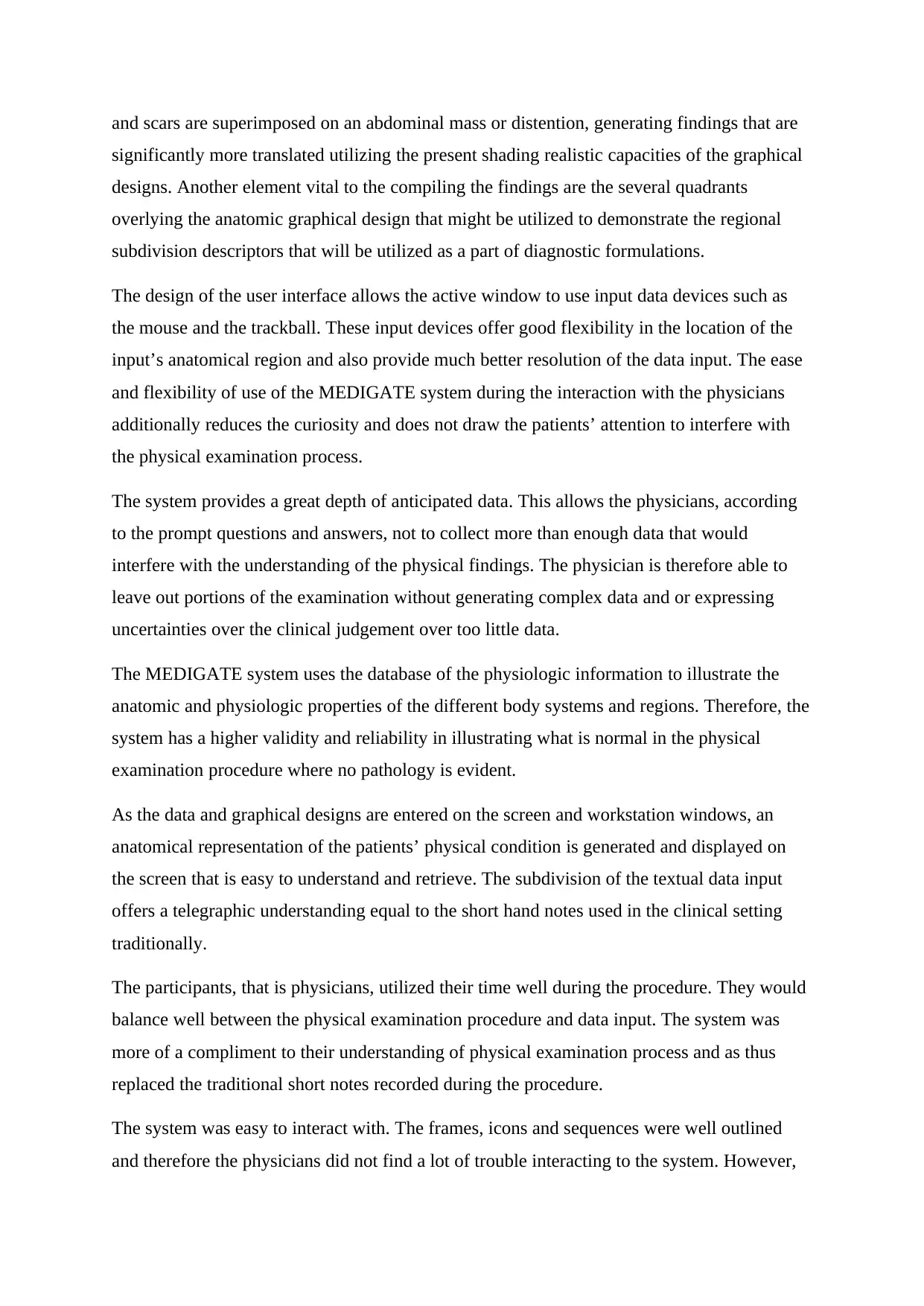
and scars are superimposed on an abdominal mass or distention, generating findings that are
significantly more translated utilizing the present shading realistic capacities of the graphical
designs. Another element vital to the compiling the findings are the several quadrants
overlying the anatomic graphical design that might be utilized to demonstrate the regional
subdivision descriptors that will be utilized as a part of diagnostic formulations.
The design of the user interface allows the active window to use input data devices such as
the mouse and the trackball. These input devices offer good flexibility in the location of the
input’s anatomical region and also provide much better resolution of the data input. The ease
and flexibility of use of the MEDIGATE system during the interaction with the physicians
additionally reduces the curiosity and does not draw the patients’ attention to interfere with
the physical examination process.
The system provides a great depth of anticipated data. This allows the physicians, according
to the prompt questions and answers, not to collect more than enough data that would
interfere with the understanding of the physical findings. The physician is therefore able to
leave out portions of the examination without generating complex data and or expressing
uncertainties over the clinical judgement over too little data.
The MEDIGATE system uses the database of the physiologic information to illustrate the
anatomic and physiologic properties of the different body systems and regions. Therefore, the
system has a higher validity and reliability in illustrating what is normal in the physical
examination procedure where no pathology is evident.
As the data and graphical designs are entered on the screen and workstation windows, an
anatomical representation of the patients’ physical condition is generated and displayed on
the screen that is easy to understand and retrieve. The subdivision of the textual data input
offers a telegraphic understanding equal to the short hand notes used in the clinical setting
traditionally.
The participants, that is physicians, utilized their time well during the procedure. They would
balance well between the physical examination procedure and data input. The system was
more of a compliment to their understanding of physical examination process and as thus
replaced the traditional short notes recorded during the procedure.
The system was easy to interact with. The frames, icons and sequences were well outlined
and therefore the physicians did not find a lot of trouble interacting to the system. However,
significantly more translated utilizing the present shading realistic capacities of the graphical
designs. Another element vital to the compiling the findings are the several quadrants
overlying the anatomic graphical design that might be utilized to demonstrate the regional
subdivision descriptors that will be utilized as a part of diagnostic formulations.
The design of the user interface allows the active window to use input data devices such as
the mouse and the trackball. These input devices offer good flexibility in the location of the
input’s anatomical region and also provide much better resolution of the data input. The ease
and flexibility of use of the MEDIGATE system during the interaction with the physicians
additionally reduces the curiosity and does not draw the patients’ attention to interfere with
the physical examination process.
The system provides a great depth of anticipated data. This allows the physicians, according
to the prompt questions and answers, not to collect more than enough data that would
interfere with the understanding of the physical findings. The physician is therefore able to
leave out portions of the examination without generating complex data and or expressing
uncertainties over the clinical judgement over too little data.
The MEDIGATE system uses the database of the physiologic information to illustrate the
anatomic and physiologic properties of the different body systems and regions. Therefore, the
system has a higher validity and reliability in illustrating what is normal in the physical
examination procedure where no pathology is evident.
As the data and graphical designs are entered on the screen and workstation windows, an
anatomical representation of the patients’ physical condition is generated and displayed on
the screen that is easy to understand and retrieve. The subdivision of the textual data input
offers a telegraphic understanding equal to the short hand notes used in the clinical setting
traditionally.
The participants, that is physicians, utilized their time well during the procedure. They would
balance well between the physical examination procedure and data input. The system was
more of a compliment to their understanding of physical examination process and as thus
replaced the traditional short notes recorded during the procedure.
The system was easy to interact with. The frames, icons and sequences were well outlined
and therefore the physicians did not find a lot of trouble interacting to the system. However,
Paraphrase This Document
Need a fresh take? Get an instant paraphrase of this document with our AI Paraphraser
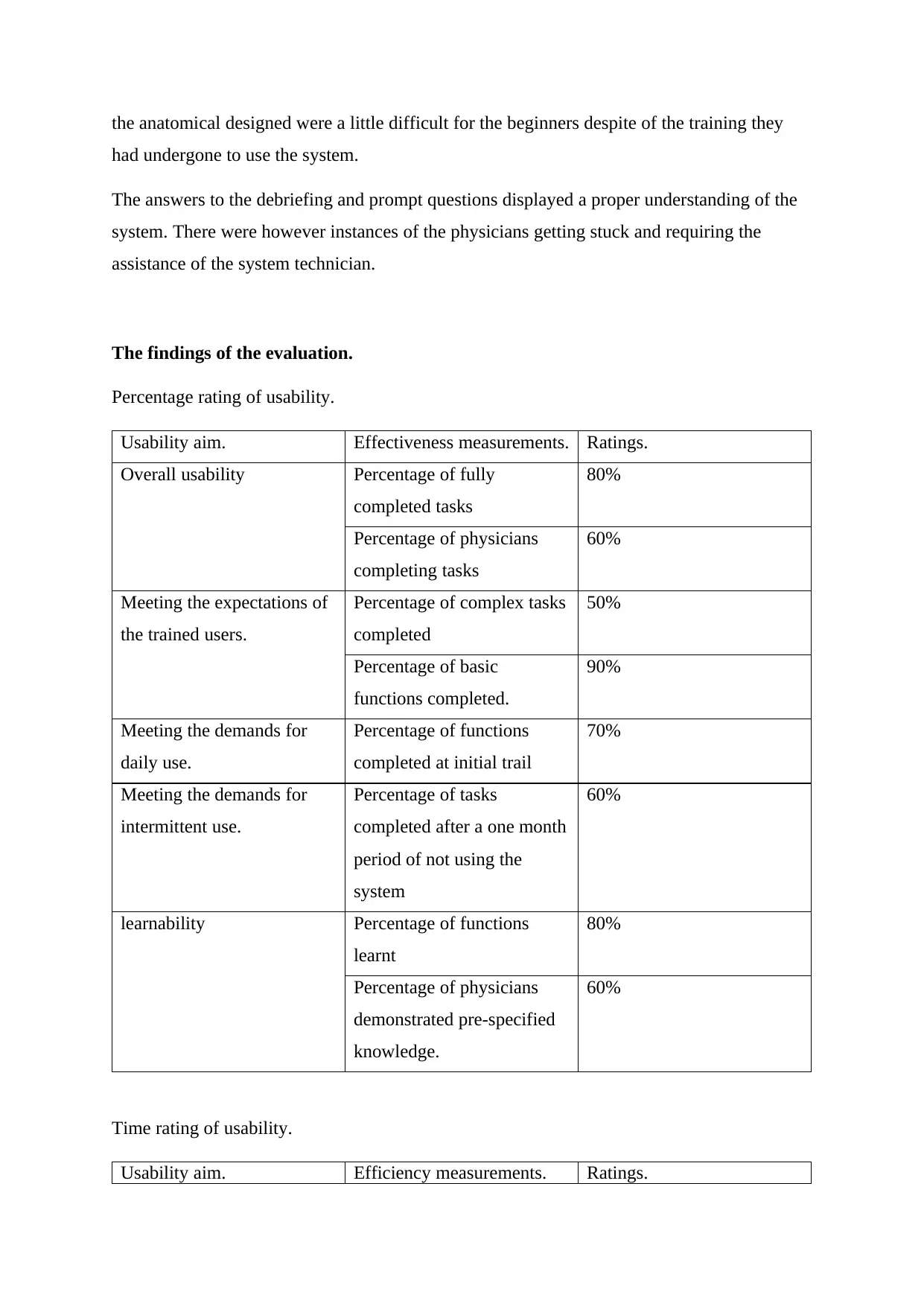
the anatomical designed were a little difficult for the beginners despite of the training they
had undergone to use the system.
The answers to the debriefing and prompt questions displayed a proper understanding of the
system. There were however instances of the physicians getting stuck and requiring the
assistance of the system technician.
The findings of the evaluation.
Percentage rating of usability.
Usability aim. Effectiveness measurements. Ratings.
Overall usability Percentage of fully
completed tasks
80%
Percentage of physicians
completing tasks
60%
Meeting the expectations of
the trained users.
Percentage of complex tasks
completed
50%
Percentage of basic
functions completed.
90%
Meeting the demands for
daily use.
Percentage of functions
completed at initial trail
70%
Meeting the demands for
intermittent use.
Percentage of tasks
completed after a one month
period of not using the
system
60%
learnability Percentage of functions
learnt
80%
Percentage of physicians
demonstrated pre-specified
knowledge.
60%
Time rating of usability.
Usability aim. Efficiency measurements. Ratings.
had undergone to use the system.
The answers to the debriefing and prompt questions displayed a proper understanding of the
system. There were however instances of the physicians getting stuck and requiring the
assistance of the system technician.
The findings of the evaluation.
Percentage rating of usability.
Usability aim. Effectiveness measurements. Ratings.
Overall usability Percentage of fully
completed tasks
80%
Percentage of physicians
completing tasks
60%
Meeting the expectations of
the trained users.
Percentage of complex tasks
completed
50%
Percentage of basic
functions completed.
90%
Meeting the demands for
daily use.
Percentage of functions
completed at initial trail
70%
Meeting the demands for
intermittent use.
Percentage of tasks
completed after a one month
period of not using the
system
60%
learnability Percentage of functions
learnt
80%
Percentage of physicians
demonstrated pre-specified
knowledge.
60%
Time rating of usability.
Usability aim. Efficiency measurements. Ratings.
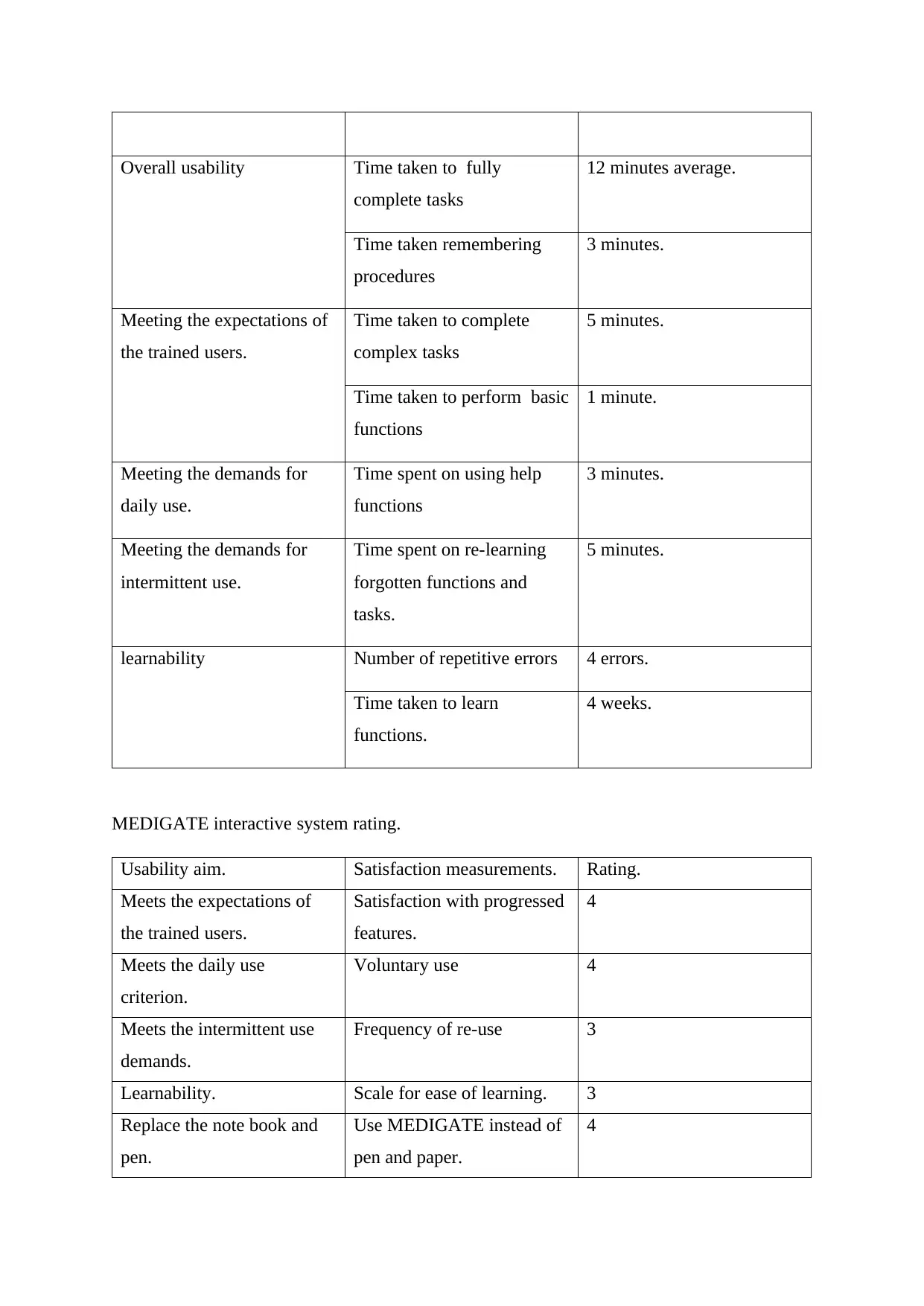
Overall usability Time taken to fully
complete tasks
12 minutes average.
Time taken remembering
procedures
3 minutes.
Meeting the expectations of
the trained users.
Time taken to complete
complex tasks
5 minutes.
Time taken to perform basic
functions
1 minute.
Meeting the demands for
daily use.
Time spent on using help
functions
3 minutes.
Meeting the demands for
intermittent use.
Time spent on re-learning
forgotten functions and
tasks.
5 minutes.
learnability Number of repetitive errors 4 errors.
Time taken to learn
functions.
4 weeks.
MEDIGATE interactive system rating.
Usability aim. Satisfaction measurements. Rating.
Meets the expectations of
the trained users.
Satisfaction with progressed
features.
4
Meets the daily use
criterion.
Voluntary use 4
Meets the intermittent use
demands.
Frequency of re-use 3
Learnability. Scale for ease of learning. 3
Replace the note book and
pen.
Use MEDIGATE instead of
pen and paper.
4
complete tasks
12 minutes average.
Time taken remembering
procedures
3 minutes.
Meeting the expectations of
the trained users.
Time taken to complete
complex tasks
5 minutes.
Time taken to perform basic
functions
1 minute.
Meeting the demands for
daily use.
Time spent on using help
functions
3 minutes.
Meeting the demands for
intermittent use.
Time spent on re-learning
forgotten functions and
tasks.
5 minutes.
learnability Number of repetitive errors 4 errors.
Time taken to learn
functions.
4 weeks.
MEDIGATE interactive system rating.
Usability aim. Satisfaction measurements. Rating.
Meets the expectations of
the trained users.
Satisfaction with progressed
features.
4
Meets the daily use
criterion.
Voluntary use 4
Meets the intermittent use
demands.
Frequency of re-use 3
Learnability. Scale for ease of learning. 3
Replace the note book and
pen.
Use MEDIGATE instead of
pen and paper.
4
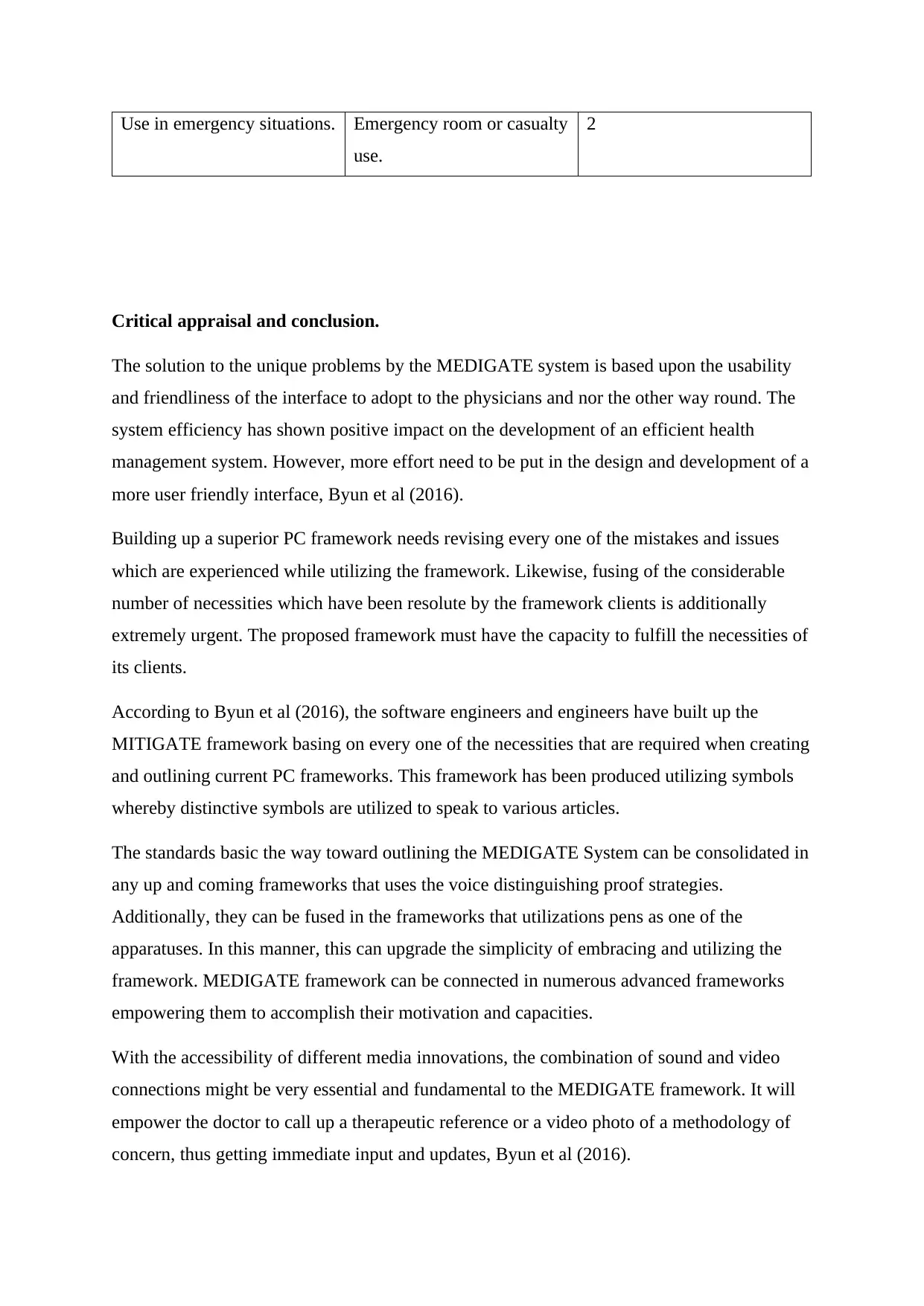
Use in emergency situations. Emergency room or casualty
use.
2
Critical appraisal and conclusion.
The solution to the unique problems by the MEDIGATE system is based upon the usability
and friendliness of the interface to adopt to the physicians and nor the other way round. The
system efficiency has shown positive impact on the development of an efficient health
management system. However, more effort need to be put in the design and development of a
more user friendly interface, Byun et al (2016).
Building up a superior PC framework needs revising every one of the mistakes and issues
which are experienced while utilizing the framework. Likewise, fusing of the considerable
number of necessities which have been resolute by the framework clients is additionally
extremely urgent. The proposed framework must have the capacity to fulfill the necessities of
its clients.
According to Byun et al (2016), the software engineers and engineers have built up the
MITIGATE framework basing on every one of the necessities that are required when creating
and outlining current PC frameworks. This framework has been produced utilizing symbols
whereby distinctive symbols are utilized to speak to various articles.
The standards basic the way toward outlining the MEDIGATE System can be consolidated in
any up and coming frameworks that uses the voice distinguishing proof strategies.
Additionally, they can be fused in the frameworks that utilizations pens as one of the
apparatuses. In this manner, this can upgrade the simplicity of embracing and utilizing the
framework. MEDIGATE framework can be connected in numerous advanced frameworks
empowering them to accomplish their motivation and capacities.
With the accessibility of different media innovations, the combination of sound and video
connections might be very essential and fundamental to the MEDIGATE framework. It will
empower the doctor to call up a therapeutic reference or a video photo of a methodology of
concern, thus getting immediate input and updates, Byun et al (2016).
use.
2
Critical appraisal and conclusion.
The solution to the unique problems by the MEDIGATE system is based upon the usability
and friendliness of the interface to adopt to the physicians and nor the other way round. The
system efficiency has shown positive impact on the development of an efficient health
management system. However, more effort need to be put in the design and development of a
more user friendly interface, Byun et al (2016).
Building up a superior PC framework needs revising every one of the mistakes and issues
which are experienced while utilizing the framework. Likewise, fusing of the considerable
number of necessities which have been resolute by the framework clients is additionally
extremely urgent. The proposed framework must have the capacity to fulfill the necessities of
its clients.
According to Byun et al (2016), the software engineers and engineers have built up the
MITIGATE framework basing on every one of the necessities that are required when creating
and outlining current PC frameworks. This framework has been produced utilizing symbols
whereby distinctive symbols are utilized to speak to various articles.
The standards basic the way toward outlining the MEDIGATE System can be consolidated in
any up and coming frameworks that uses the voice distinguishing proof strategies.
Additionally, they can be fused in the frameworks that utilizations pens as one of the
apparatuses. In this manner, this can upgrade the simplicity of embracing and utilizing the
framework. MEDIGATE framework can be connected in numerous advanced frameworks
empowering them to accomplish their motivation and capacities.
With the accessibility of different media innovations, the combination of sound and video
connections might be very essential and fundamental to the MEDIGATE framework. It will
empower the doctor to call up a therapeutic reference or a video photo of a methodology of
concern, thus getting immediate input and updates, Byun et al (2016).
Secure Best Marks with AI Grader
Need help grading? Try our AI Grader for instant feedback on your assignments.

It is trusted that these standards will assume an imperative part in future PC based therapeutic
data frameworks by empowering the gathering of pertinent data and accommodating
introduction and most extreme usage of the information, thus advancing the courses on which
the patients are dealt with, administration and controlling of the mistakes in the frameworks,
and improving the looks into that are identified with the field of medication.
However sufficient examination of the usefulness of the framework is just valuable when the
deformities of the framework are managed upon in an auspicious way. Evaluators and
architects require a sorted out rundown of discoveries for organizing upgrade work. The
software engineers ought to settle the mistakes that are recognized while the framework is
working.
The report ought to be organized by either regions of the framework concerned, or by
seriousness of the issue. For the last mentioned, a five-point scale ought to be received,
running from 'would keep client from continuing further' to 'minor bothering'. Including a
note of the general ease of use rule concerned may enable planners to comprehend why there
is a trouble, however regularly more specific elaboration will be required. In lieu, some of the
time the issue is apparent to the point that clarification is excess, Byun et al (2016). An eye to
eye meeting may have more impact than a composed archive alone and this would be the
perfect scene for indicating short video clasps and playing sound records of client issues,
Physicians and other medical professionals will definitely benefit from the interaction with
the MEDIGATE system in data entry to compliment the process of medical judgement in
clinical diagnosis and management.
The user interface focus broadly generates a need to perform a detailed physical examination
and hence will improve the overall process. When integrated into electronic health records
and artificial intelligence programs such as deep learning, the MEDIGATE system will
transform the practice of medicine into a service efficient system with better patient care
delivery and information relevant for clinical research, Byun et al (2016).
data frameworks by empowering the gathering of pertinent data and accommodating
introduction and most extreme usage of the information, thus advancing the courses on which
the patients are dealt with, administration and controlling of the mistakes in the frameworks,
and improving the looks into that are identified with the field of medication.
However sufficient examination of the usefulness of the framework is just valuable when the
deformities of the framework are managed upon in an auspicious way. Evaluators and
architects require a sorted out rundown of discoveries for organizing upgrade work. The
software engineers ought to settle the mistakes that are recognized while the framework is
working.
The report ought to be organized by either regions of the framework concerned, or by
seriousness of the issue. For the last mentioned, a five-point scale ought to be received,
running from 'would keep client from continuing further' to 'minor bothering'. Including a
note of the general ease of use rule concerned may enable planners to comprehend why there
is a trouble, however regularly more specific elaboration will be required. In lieu, some of the
time the issue is apparent to the point that clarification is excess, Byun et al (2016). An eye to
eye meeting may have more impact than a composed archive alone and this would be the
perfect scene for indicating short video clasps and playing sound records of client issues,
Physicians and other medical professionals will definitely benefit from the interaction with
the MEDIGATE system in data entry to compliment the process of medical judgement in
clinical diagnosis and management.
The user interface focus broadly generates a need to perform a detailed physical examination
and hence will improve the overall process. When integrated into electronic health records
and artificial intelligence programs such as deep learning, the MEDIGATE system will
transform the practice of medicine into a service efficient system with better patient care
delivery and information relevant for clinical research, Byun et al (2016).

References.
Dix, A. (2009). Human-computer interaction. In Encyclopedia of database systems (pp. 1327-
1331). Springer US.
Reisner, P. (2011). Formal grammar and human factors design of an interactive graphics
system. IEEE Transactions on Software Engineering, (2), 229-240.
Chin, J. P. (2011, May). Development of an instrument measuring user satisfaction of the
human-computer interface. In Proceedings of the SIGCHI conference on Human factors in
computing systems (pp. 213-218). ACM.
Whitefield, A., Wilson, F., & Dowell, J. (2013). A framework for human factors evaluation.
Behaviour & Information Technology, 10(1), 65-79.
Yoder, J. W. (2012). The role of human-computer interaction in medical information
systems: Principles and implementation of MEDIGATE (Master's thesis, University of
Illinois at Urbana-Champaign).
Yoder, J. W., Schultz, D. F., & Williams, B. T. (2008). The MEDIGATE graphical user
interface for entry of physical findings: design principles and implementation. Journal of
medical systems, 22(5), 325-337.
Williams, B. T. (2014). The MEDIGATE System for Direct Entry of Physical Findings by
the Examiner User Interface Issues Ben T. Williams, MD, Joseph W. Yoder, BS and Donald
F. Schultz, MD Lifespan Research Institute, Urbana IL.
Byun, S. J., Hwang, S. H., Kim, J. H., Ban, J. S., & Min, B. W. (2006). Email: tristan70@
medigate. net. Korean Journal of Anesthesiology, 50(2), 140-145.
Bibliography
Woodson, W.E., Tillman, B. and Tillman, P.( 2010). Human factors design handbook:
information and guidelines for the design of systems, facilities, equipment, and products for
human use.
Sheridan, T.B., (2012). Humans and automation: System design and research issues. Human
Factors and Ergonomics Society.
Dix, A. (2009). Human-computer interaction. In Encyclopedia of database systems (pp. 1327-
1331). Springer US.
Reisner, P. (2011). Formal grammar and human factors design of an interactive graphics
system. IEEE Transactions on Software Engineering, (2), 229-240.
Chin, J. P. (2011, May). Development of an instrument measuring user satisfaction of the
human-computer interface. In Proceedings of the SIGCHI conference on Human factors in
computing systems (pp. 213-218). ACM.
Whitefield, A., Wilson, F., & Dowell, J. (2013). A framework for human factors evaluation.
Behaviour & Information Technology, 10(1), 65-79.
Yoder, J. W. (2012). The role of human-computer interaction in medical information
systems: Principles and implementation of MEDIGATE (Master's thesis, University of
Illinois at Urbana-Champaign).
Yoder, J. W., Schultz, D. F., & Williams, B. T. (2008). The MEDIGATE graphical user
interface for entry of physical findings: design principles and implementation. Journal of
medical systems, 22(5), 325-337.
Williams, B. T. (2014). The MEDIGATE System for Direct Entry of Physical Findings by
the Examiner User Interface Issues Ben T. Williams, MD, Joseph W. Yoder, BS and Donald
F. Schultz, MD Lifespan Research Institute, Urbana IL.
Byun, S. J., Hwang, S. H., Kim, J. H., Ban, J. S., & Min, B. W. (2006). Email: tristan70@
medigate. net. Korean Journal of Anesthesiology, 50(2), 140-145.
Bibliography
Woodson, W.E., Tillman, B. and Tillman, P.( 2010). Human factors design handbook:
information and guidelines for the design of systems, facilities, equipment, and products for
human use.
Sheridan, T.B., (2012). Humans and automation: System design and research issues. Human
Factors and Ergonomics Society.

Blanchard, B.S., Fabrycky, W.J. and Fabrycky, W.J.,( 2016). Systems engineering and
analysis (Vol. 4). Englewood Cliffs, NJ: Prentice Hall.
Bannon, L.J., (2009). From human factors to human actors: The role of psychology and
human-computer interaction studies in system design. In Readings in Human–Computer
Interaction(pp. 205-214).
analysis (Vol. 4). Englewood Cliffs, NJ: Prentice Hall.
Bannon, L.J., (2009). From human factors to human actors: The role of psychology and
human-computer interaction studies in system design. In Readings in Human–Computer
Interaction(pp. 205-214).
1 out of 13
Related Documents
Your All-in-One AI-Powered Toolkit for Academic Success.
+13062052269
info@desklib.com
Available 24*7 on WhatsApp / Email
![[object Object]](/_next/static/media/star-bottom.7253800d.svg)
Unlock your academic potential
© 2024 | Zucol Services PVT LTD | All rights reserved.




